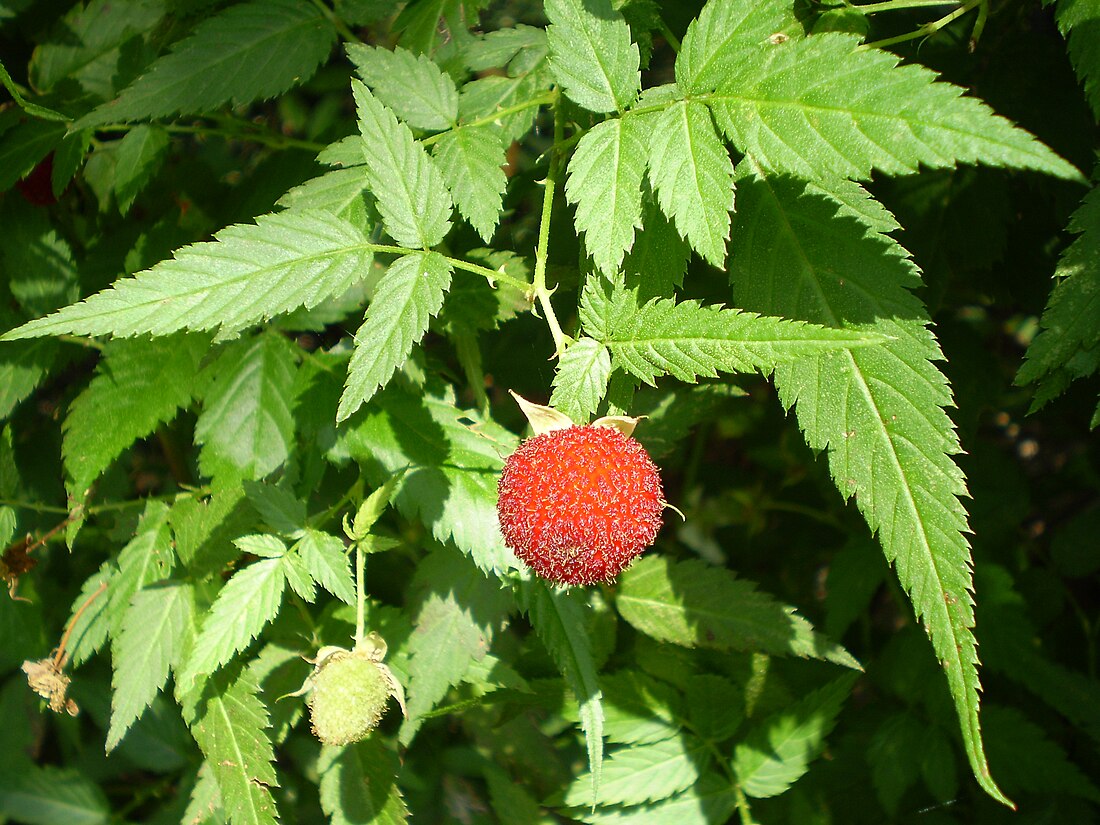Top Qs
Timeline
Chat
Perspective
Rubus rosifolius
Species of plant in the rose family From Wikipedia, the free encyclopedia
Remove ads
Rubus rosifolius, (sometimes spelled Rubus rosaefolius), also known as roseleaf bramble, Mauritius raspberry, thimbleberry, Vanuatu raspberry and bramble of the Cape[2] is a species of prickly subshrub. Its double-flowered variety is named Rubus rosifolius var. coronarius (synonym: Rubus coronarius).[3]
Remove ads
Description
Roseleaf bramble is a shrub with straight or arching stems that can reach as much as 2.5 meters (8.2 ft) in height. The stems are covered in long, spreading white hairs with scattered amber-green glands that can be dense in small areas.[4] Their leaves are compound with toothed margins, with glandular-hairs on both sides of leaflets. The flowers are white in panicles or solitary.[5] The fruit are 2 cm long.
Remove ads
Taxonomy
Summarize
Perspective
Rubus rosifolius was given its scientific name by the botanist James Edward Smith in 1791.[1] The unplaced name Rubus rosifolius published by Jonathan S. Stokes in 1812 is sometimes a source of confusion.[6] According to Plants of the World Online it has no accepted subspecies, but has two accepted varieties.[1] The autonymic variety has 40 heterotypic synonyms while Rubus rosifolius var. inermis has none.[7][8]
Remove ads
Distribution and habitat
Summarize
Perspective

Rubus rosifolius is native to India, Southeast Asia, and some islands of the western Pacific. It is also widely introduced to areas of Australia, Africa, South America, Central America, and to other Pacific islands.[1]
Its native range extends as far west as Nepal, Sri Lanka, and India where it is found mainly in the northeast in the states of Arunachal Pradesh, Assam, Manipur, Meghalaya, Mizoram, Nagaland, Sikkim, Tripura, and West Bengal, but also is native to Himachal Pradesh and Uttarakhand in the northwest and Tamil Nadu in the south. To the east it is native to all the states of Mainland Southeast Asia except for Singapore. In China it is mainly found in the southeast being native to Anhui, Fujian, Guangdong, Guangxi, Hubei, Hunan, Jiangxi, and Zhejiang, but in the south it is found as far west as Guizhou, Sichuan, and Yunnan and as far north as Shaanxi. It is also native to the island of Taiwan. It is native to many of the Islands of Indonesia including Borneo, and Sulawesi as well as both halves of New Guinea[9]
Rubus rosifolius has become naturalized in eastern Australia and in New Zealand. It has escaped from cultivation or been introduced to many islands including Vanuatu, New Caledonia, Hiva Oa in the Marquesas Islands, the Hawaiian Islands, Tahiti, Moʻorea, Raʻiātea, Rapa Iti, Ascension Island, and St. Helena.[9] It is also found abundantly in the Brazilian states Minas Gerais, Rio de Janeiro and to the south as far as Rio Grande do Sul.[10]
The species is grows naturally in rainforests and tall open forests.[10]
Weed risk
Rubus rosifolius is an introduced environmental weed in the Hawaiian Islands, Puerto Rico and French Polynesia; extreme caution should be adopted when considering introducing this plant into regions where it is not already native.[11][12]
Uses
Although rarely cultivated, the plant has several uses. The fruit is sweet and pleasant flavoured when grown with good soil moisture. The fruit is also sold at markets in the Himalayas.[13]
The leaf is used as a medicinal herbal tea for treating diarrhoea, menstrual pains, morning sickness and labour pains.[14] The leaf contains essential oils.[15]
References
External links
Wikiwand - on
Seamless Wikipedia browsing. On steroids.
Remove ads


